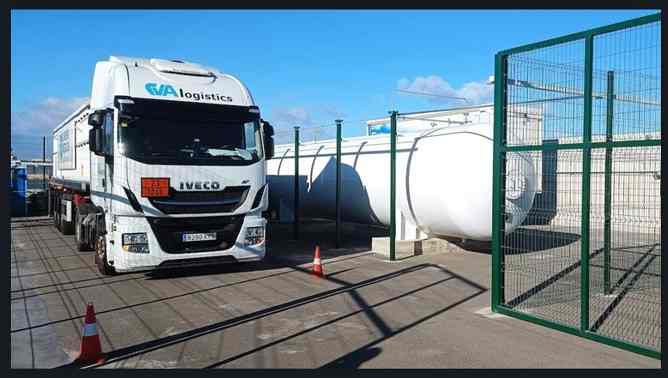The Port of Valencia, the first in Europe to use hydrogen technology
During this first quarter of the year, the other two prototypes of this project will arrive at the Valencian premises: A ‘Reachstacker’ or container stacker and a 4×4 tractor unit.
The Port of Hydrogen is Valencia. The first consignment of hydrogen (H2) to supply the supply station at the Xità dock has arrived at the Valencian location.

A significant historical achievement makes it the first port in Europe with a hydrogen plant that is operational.
It is the only facility equipped with a fixed hydrogen fuel storage tank and a movable hydrogen fuel supply that can meet the demands of the terminals.
A turning moment in the testing of one of the fuels of the future for the port community and European ports.
This hydrogen supply station (HRS for its acronym in English) includes a fixed part that is dedicated to the reception, storage, and compression of hydrogen up to the delivery pressure.
The test was carried out, and a part mobile that stores compressed hydrogen and has a dispenser for refueling port machinery.
The first tube trailer with green hydrogen cylinders that had been placed into the port of Valencia’s storage tank arrived at the hydrogen production facilities this morning around 10:30 a.m.
For almost an hour, several tests were conducted to get everything ready to start filling the permanent tank with H2 situated on the Xità wharf.
Technicians from the Valencia Port Authority (APV), the Valenciaport Foundation, the National Hydrogen Center -in charge of designing and building the station-, and Carburos Metálicos -a company that provides the hydrogen- were present at the test.
The two-port machinery prototypes that will soon come and be tested with this clean fuel, the MSC and Grimaldi terminals, will be supplied with hydrogen by the mobile station that will be in charge of traveling there next week.
Specifically, it tested on a ‘Reachstacker’ vehicle or container stacker and a 4×4 tractor unit.
A group of Valenciaport stevedores and experts will go to the Netherlands in the coming weeks to test the Reachstacker, which is being developed by the company (Hyster Europa).
Atena Distretto is modifying the ro-ro tractor. Both will operate using fuel cells and electric motors that will both produce no emissions and be powered by H2.
Raul Cascajo, the PAV’s director of environmental policies, has emphasized that “this project is crucial for the reduction of emissions and contributes to other measures like the building of solar plants or wind turbines to reach our promise to be an emissions-free port in 2030.
This H2Ports project is the first to evaluate mobility and its use in machinery in a European port.
With this milestone of the first charge of hydrogen from the supply station, we value and make real the commitment of Valenciaport to decarbonization”.
Today is a crucial day for the Port of Valencia since it marks the beginning of our work with renewable hydrogen after we filled the hydro generator with it.
According to Aurelio Lázaro, director of the Valenciaport Foundation’s H2Ports project, this initiative is a component of Valenciaport’s decarbonization ambitions and is a step closer to the port being an emission-neutral port and achieving zero emissions by the year 2030.
The next phase is to test the use of H2 in the tractor unit and reach stacker machines, two ground-breaking vehicles that will enable it to be confirmed that this fuel is being used in port operations.
The National Hydrogen Center’s Cristina Ballester has emphasized the significance of “introducing hydrogen technologies at a port as strategic as that of Valencia through a portable station to give this clean fuel to the two equipment prototypes in the MSC and Grimaldi terminals.”
It is a very ambitious research project to make ports capable of producing hydrogen and self-managing so that all port gear operates with zero emissions.
That such significant initiatives advance engineering and research in Spain, according to Cristina Ballester is a huge asset and vital to position our nation.
Project supported by the European Union
Implementing Fuel Cells and Hydrogen Technologies in Ports is a project of H2Ports.
This project is funded by the Clean Hydrogen JU program of the European Union and is directed by the Valenciaport Foundation in partnership with the Valencia Port Authority (APV).
Its goal is to test and evaluate hydrogen technologies on port machinery so genuine solutions are found without compromising port operations performance and safety and without emitting any local pollutants.
The Valenciaport Foundation, the PAV, the research institutes Centro Nacional del Hydrogen and Atena Distretto Alta Tecnologia Energia Ambiente, and the for-profit companies MSC Terminal Valencia, Grimaldi Group, Hyster-Yale, Ballard Power Systems Europe, Metallic Carbides, and Enagás, will all contribute to the H2Ports project, which will cost over 4 million euros overall.
Valenciaport is dedicated to combating global warming and promoting decarbonization through a variety of initiatives to be an emissions-neutral region by 2030.
Related Post
